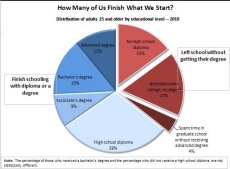
An official website of the United States government
Here’s how you know
Official websites use .gov
A .gov website belongs to an official government organization in the United States.
Secure .gov websites use HTTPS
A lock (
) or https:// means you’ve safely connected to the .gov website. Share sensitive information only on official, secure websites.
-
//
- Census.gov /
- Census Blogs /
- Random Samplings /
- Finishing What We Start
Finishing What We Start?
Finishing What We Start?
Ideally, in life, people hope to finish what they start. But when it comes to an education, for a variety of reasons, things don’t always work out that way. Data from the Census Bureau’s Current Population Survey bears this out.
More than one in three adults 25 and older in 2010 left school before being awarded the degree they were presumably aiming for. This includes 15 percent of the population who did not earn a regular high school diploma, the group sometimes labeled “dropouts.” (About 2 percent earned a GED and roughly 1 percent were close, even reaching the 12th grade.) An even greater share of the 25-and-older population, 17 percent, attended some college but left before receiving a degree. Rounding out the list were 4 percent who spent some time in graduate school without getting an advanced degree to show for their efforts.
On the other hand, most adults 25 and older (64 percent) did finish their schooling with a diploma or degree. The most common of these is a high school diploma, which was the highest level attained by 30 percent of those 25 and older. Another 9 percent left school with an associate’s degree, and 15 percent finished with a bachelor’s degree, which did not differ statistically from those who did not earn a high school diploma. Finally, 11 percent completed an advanced degree.
These data come from tabulations on Educational Attainment in the United States: 2010 and not only examine gender differences in attainment but also provide the most detailed information on years of school completed ever presented by the Census Bureau, showing for each level of attainment exactly how many years of education adults have. The Current Population Survey’s Annual Social and Economic Supplement is conducted in February, March and April at about 100,000 addresses nationwide.
Share
 Yes
Yes
 No
NoComments or suggestions?


Top

